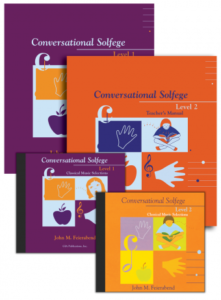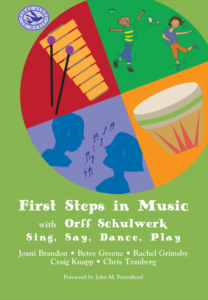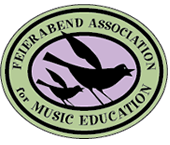Game Changers: Conversational Solfege Techniques with Orff Schulwerk Inspiration
By Betsy Greene, FAME Teacher Trainer
Often referred to as games, the techniques are used throughout every stage and step of Conversational Solfege to develop understanding and skill. They are truly the power (and arguably the fun) behind the 12 Steps. Most importantly, they are what drives the learning in Conversational Solfege.
Orff Schulwerk is best known for the use of improvisation and for students being able to make their own artistic decisions for their music making. By providing students with a problem (e.g. How can we make an accompaniment? How can we create an introduction?), students are guided through the processes of imitation, exploration, improvisation, and composition with music and movement to develop their own musical solution.
So, what would happen if we were to apply this central principal of student choice to a technique or game in Conversational Solfege? The technique would become the springboard for using student choice to solve a musical problem and make additional learning opportunities for students. Any musical element such as dynamics, form, timbre, texture, harmony, tempo may be experienced through their solution to the musical problem not just melody and rhythm or the music literacy objectives. This is a game changer for student learning.
 So let’s do it – apply student choice to a technique at one of the 12 Steps. For ease of explaining, let’s use the rhythmic Unit 1 at Step 3: Conversationally Decode – Familiar with the “Spell This” technique from Conversational Solfege Level 1 Teacher’s Manual (2001) : p. 25 and a simple musical problem to create a complimentary rhythmic ostinato to accompany a familiar song.
So let’s do it – apply student choice to a technique at one of the 12 Steps. For ease of explaining, let’s use the rhythmic Unit 1 at Step 3: Conversationally Decode – Familiar with the “Spell This” technique from Conversational Solfege Level 1 Teacher’s Manual (2001) : p. 25 and a simple musical problem to create a complimentary rhythmic ostinato to accompany a familiar song.
Next, let’s choose an age group and familiar song. The age group will be upper elementary and the familiar song will be one of my favorite rounds “Old Abram Brown” from Feierabend’s Book of Canons (Revised edition) (2014). This song is being labeled as familiar which assumes students already know how to sing this song independently and in a round.
Below is procedural outline of how this idea of integrating techniques with Orff Schulwerk inspired student choice might possibly unfold over several lessons so the class time is not completely monopolized to complete this activity. Spreading out the activity over several lessons is also highly recommended especially if you meet with your students only once a week. Also noted in this outline are other music elements experienced through the lessons. The culminating lesson could be brought straight to a concert/informance.
Procedure
Lesson 1:
- Teacher uses the technique “Spell This” for students to conversationally decode familiar Pattern Set 1A (Conversational Solfege Level 1 88). Teacher says pattern on neutral syllable and students conversationally decode the pattern using rhythm syllables.
- Teacher guides the students into exploring Pattern Set 1A through body percussion using the more advanced “Spell This” technique (teacher plays the pattern rather than speak it on neutral syllable.) Teacher performs each pattern with body percussion (pat on legs for eighth notes and clap for quarter notes) and students conversationally decode each pattern using rhythm syllables. After students have conversationally decoded each pattern, they are invited to perform the pattern with body percussion as presented by the teacher. Important: Students should always speak the pattern with syllables before using body percussion or any instrumental application.
- Teacher invites students to perform the last pattern as an ostinato with body percussion as presented by the teacher while the teacher sings the familiar round (song) “Old Abram Brown.”
- Teacher leads students to explore a few more patterns from Pattern Set 1A in this way – students play pattern as a body percussion ostinato while teacher sings the song. Remember to always to have students conversationally decode pattern with rhythmic syllables before inviting students to play with body percussion.
Lesson 2:
- Quick review: Repeat the fourth step from Lesson 3. Remember to have students decode the pattern conversationally before applying to body percussion.
- Teacher invites students to choose a pattern from the ones explored in the previous step to set as an ostinato to perform. Students sing the song in unison while performing the ostinato. The teacher here acts as a facilitator in choosing the pattern for the ostinato. This provides an opportunity to learn about complimentary patterns.
- Teacher splits the class into two or more small groups. The class now performs the chosen pattern with body percussion while performing “Old Abram Brown” in a round. Group 1 starts, followed by Group 2, etc.
- Teacher records (for teacher use) which pattern was selected for use in next lesson. This is not for students to see but for the teacher to use to begin the next lesson.
Lesson 3:
- Teacher reviews song and the chosen pattern from the previous lesson through the “Spell This” technique (students conversationally decode the pattern.)
- Teacher guides students through exploring different ways to play the ostinato pattern – using different body percussion, with or without a partner, in a group, transferred to instruments.
- Teacher divides class into two or more small groups. Teacher invites each group to set in their own way how they are going to perform the ostinato pattern. Remind students to use ideas from the earlier exploration in the previous step for inspiration.
- Groups record what they used for body percussion or timbre and movement (performed in a circle, a line, while stepping, changing places, etc.) to be able to use in next lesson.
Lesson 4:
- Teacher reviews with groups from decisions made from previous lesson and allows them time to practice singing and playing their ostinato while singing the song “Old Abram Brown.”
- Teacher guides students through trying out their ostinato with expressive elements (dynamics) and form (unison, repetitions, round, introduction, coda) as well as texture (with ostinato, without ostinato). Teacher records student decisions in regards to dynamics, form, texture, and timbre.
- Students perform song as they developed using their musical decisions.
Students sing in round and with the musical and movement decisions set in the previous step. For example: First time unison without ostinato mezzo piano, Second time in unison with ostinato mezzo forte, Third time Group 1 performs alone piano, Fourth time Group 1 & 2 performs mezzo forte, Fifth time Group 1,2,&3 performs forte, Sixth time perform in a round with the ostinato with each group entering at mezzo forte. Musical Elements: FORM DYNAMICS TIMBRE TEXTURE
 In this style of teaching, the teacher plays the role of facilitator. It is up to the teacher to guide rather than direct the learning to ensure the activity meets the learning objectives and builds upon past learning.
In this style of teaching, the teacher plays the role of facilitator. It is up to the teacher to guide rather than direct the learning to ensure the activity meets the learning objectives and builds upon past learning.
Here are two more technique and musical problem pairings to hopefully give you some additional inspiration for your own classroom. A suggestion is given for a possible CS Unit, however any CS Unit your students have completed or are currently in at the step presented in the suggestions below could be used.
Unit 4
Step 7 Read: Decode-Familiar Pattern Set 4C or 4D
Technique: Read Patterns from Transparency or Pattern Cards (CS Level 1, p. 40)
Problem: Create a contrasting section or B section to a familiar song.
Student Choice: After reading Pattern Set 4C or 4D using the technique “Read Patterns from Transparency or Pattern Cards”, students choose which patterns and what order to string together to create phrases for a B section.
Considerations for Song Selection:
- Song with four phrases work best.
- Song does not need to be from CS Unit 4 or even CS unless you would like to eventually use for CS literacy.
- Initially, choose a song that matches the meter, tonality (major), and can be sung in the key of Pattern Sets 4C or 4D
- For upper elementary or even older, using a song which contrasts either with tonality or meter of the Pattern Set 4C or 4D for deeper learning.
Unit 3
Step 5 Create
Technique: Question/Answer (CS Level 1 p. 30)
Problem: Create a call and response section for any chant or spoken rhyme which can be transferred to hand percussion.
Student Choice: After pairs of students are able to easily alternate between creating questions and answers, each pair sets one of their question and answer improvisations. Set means they use the same question and answer. After speaking their set question/answer improvisation, students transfer their question/answer to body percussion or hand percussion to perform. Class decides how to create a section using student pairs performing their set improvisation (composition.) from “Question/Answer” technique.
Considerations for Song Selections:
- Songs with even number phrases or four phrases work best.
- Consider using a spoken rhyme or chant that can be transferred to body percussion or hand percussion for entire class.
- Song/rhyme/chant does not need to be from CS Unit 4 or even CS unless you would like to use for CS literacy.
For more information on Orff Schulwerk and comparison to Conversational Solfege, for using classroom instruments with Conversational Solfege, and/or to see variations of these ideas, please see Feierabend Fundamentals: History, Philosophy, and Practice (2018), Chapter Seven (pages 201-209) and Chapter Ten (pages 322-327).
REFERENCES
Feierabend, J. (2001) Conversational Solfege Level 1 Teacher’s Manual. Chicago, IL: GIA Publications.
Feierabend, J. (2014) Book of Canons (Revised Edition). Chicago, IL GIA Publications.
Feierabend, J. and Strong, M. (editors) (2018) Feierabend Fundamentals: History, Philosophy, and Practice. Chicago, IL: GIA Publications.
Bio: Betsy Greene is currently serving as Past-President for the Feierabend Association for Music Education (FAME). She is a FAME endorsed teacher trainer for First Steps in Music and Conversational Solfege Levels 1 & 2. Betsy is a co-author for First Steps in Music with Orff Schulwerk: Sing, Say, Dance, Play (2017). Chicago, IL: GIA Publications and a contributor for Feierabend Fundamentals: History, Philosophy, and Practice (2018)Chicago, IL: GIA Publications. She also is both Orff-Schulwerk and Kodaly certified. Betsy teaches grades K-5 and chorus in Burlington, Vermont.
